Fundamental physics with positronium at the FRM 2
The negative positronium ion Ps− is a fundamental leptonic three-body system (e+e−e−) and as such purely described by QED to a very good approximation. Fig. 1 displays a sketch of the Ps-Minus ion and its allowed decay channels and the repsective branching ratios.
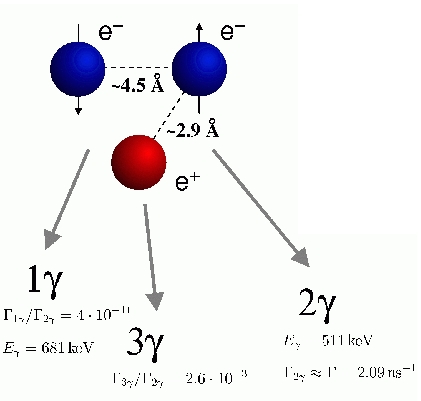
The most recent and first relativistic calculation [1] leads to a decay rate of Gamma = 2.087963(12) ns−1. With a calculated binding energy of −0.326 eV only the ground state ist stable against dissociation. It decays via e+e− annihilation in any photon number, with a greatly favoured 2 gamma decay channel. Only two decay rate measurements are available, with the most recent value [2] of Gamma = 2.089(15) ns−1. In order to exploit the unprecedented positron intensity of the worldwide strongest positron source NEPOMUC at the Garching neutron source FRM-II, the experimental setup for the Ps− experiment, developed at the Max- Planck-Institut f. Kernphysik in Heidelberg, was transferred to the NEPOMUC positron beam line in Garching [3]. The schematic setup of the experiment is shown in Fig. 2.

Fig. 2: Decay rate measurement setup at the FRM-II.
Slow positrons impinge on a 5 nm thin Diamond Like Carbon (DLC) foil, where they form Ps− with a probability of 10−4. They are accelerated across a variable length gap and the count rate of ions surviving the flight is detected. Therefore the ions are post-accelerated by a 30 kV high voltage and their two electrons are stripped off at a second DLC foil. The remaining positrons are magnetically transported to a silicon detector, which is cooled down to −20 ◦C in order to reduce background noise.
Fig. 3 displays a photograph of the actual setup at the NEPOMUC positron source of the FRM 2.
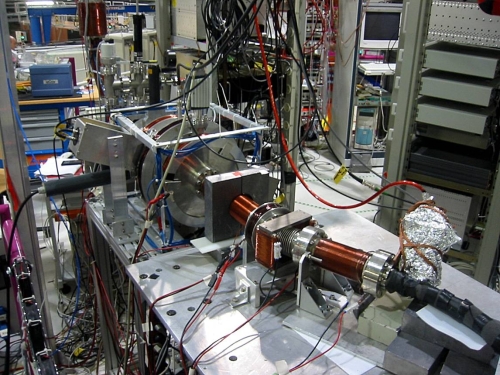
In order to reduce background in the Si detector, a magnetical chicane was introduced with a dipole acting as magnetic filter. Results from measurements with this setup show a count rate of Ps- ions of up to 5 s-1 with a signal-to-background ratio of 25:1. A typical spectrum of this measurement is shown in Fig. 4. The positron beam delivers approximately 107 (remoderated) positrons per second with an energy of 20 eV. From a recently finished production experiment it is expected to achieve a new decay rate value which is more accurate than the one reported in [2] by a factor of ~5.
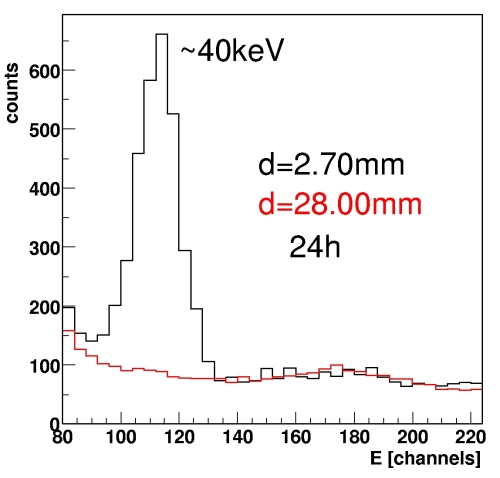
Fig. 4: Typical spectrum of a measurement of Ps-minus. The peak shows the stripped positronium ions. The background spectrum (dashed line) was recorded for a 28 mm gap distance relative to the gap distance of the first spectrum. A typical decay curve is shown in Fig. 5.
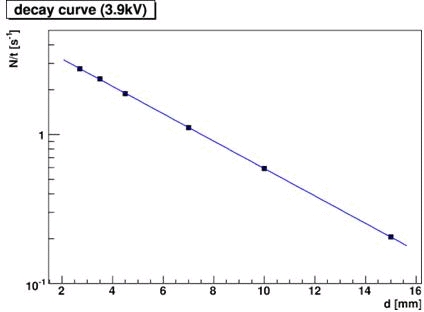
Perspective: Photodetachment Measurement
With the high positron flux provided by NEPOMUC, new experiments with Ps- come into reach. Preparations are on the way to measure the off-resonant photodetachment cross section at the two energies provided by the fundamental and the first harmonic mode of a Nd:YAG laser. These values have only been calculated [4] so far and await verification by experiment. Therefore a laser system has been acquired, which delivers a 1064 nm beam with 200 W average power or a 532 nm beam with 100 W average power, each at a repetition frequency of 10 kHz. The laser beam will be coupled into a cavity, producing a light curtain, which will be traversed by the Ps- beam. Fig. 4 shows a sketch of the planned setup.
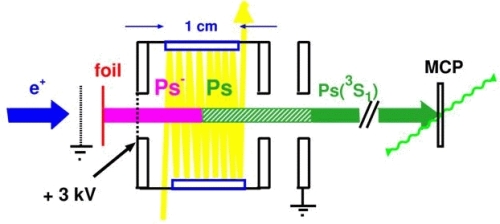
The resulting (ortho-)positronium rate is expected to be ca. 40 s-1. Higher rates of the order of 104 s-1 can be achieved by pulsing the incident positron beam as well. With this technique an energy tunable, pure ortho-positronium beam becomes available, which allows e.g. the precision study of the 1 3S1 --> 2 3S1 transition. Future experiments may also explore the Feshbach resonances expected to be seen in the resonant photodetachment cross section for determining the binding energy of Ps-.
References:
[1] M. Puchalski et al., Phys. Rev. Lett. 99 (2007) 203401.
[2] F. Fleischer et al., Phys. Rev. Lett. 96 (2006) 063401.
[3] F. Fleischer et al., MLL Annual Report (2006) 54
[4] A. Igarashi et al., New J. Phys. 2 (2000) 17.

